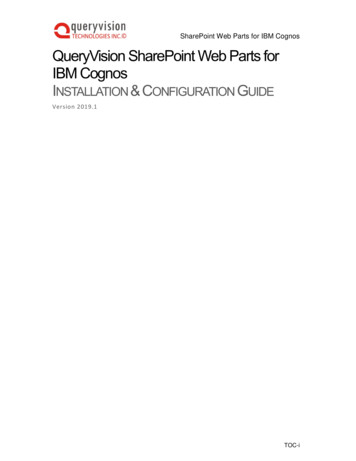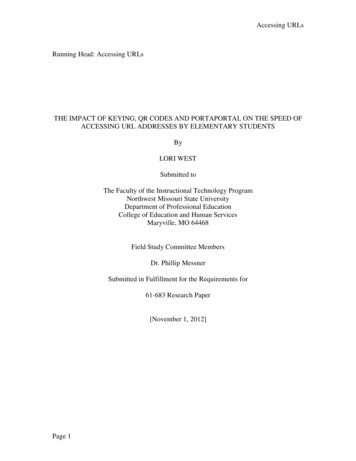
Transcription
Accessing URLsRunning Head: Accessing URLsTHE IMPACT OF KEYING, QR CODES AND PORTAPORTAL ON THE SPEED OFACCESSING URL ADDRESSES BY ELEMENTARY STUDENTSByLORI WESTSubmitted toThe Faculty of the Instructional Technology ProgramNorthwest Missouri State UniversityDepartment of Professional EducationCollege of Education and Human ServicesMaryville, MO 64468Field Study Committee MembersDr. Phillip MessnerSubmitted in Fulfillment for the Requirements for61-683 Research Paper[November 1, 2012]Page 1
Accessing URLsACKNOWLEDGEMENTSI want to thank the following people for their support throughout the research andwriting process. From developing the topic, to editing, to formatting the final paper, toinstruction on statistics, to participating in the study, to lending a listening ear, thisproject would not have been possible without them.Dr. Brian Hoffman, Park UniversityMs. Nadienne HoffmanDr. Phillip Messner, NWMSUDr. Nancy Zeliff, NWMSUMs. Trudy Ferrier, Mark Twain 3rd grade teacher and her entire classDr. Suzanne Tiemann, principal Mark Twain Elementary SchoolMs. Jennifer FrazierPage 2
Accessing URLsABSTRACTAccessing websites on the Internet can be a daunting task for students of varyingages and capabilities, especially in the elementary classroom. With the onset of one-onone technology implementation in many schools efficiency and productivity for studentsand teachers with technology requires new methods. This study seeks to investigate threemethods of accessing websites to determine a timely way of getting elementary studentsto the correct URL address. Keying the URL address, QR code scanning andbookmarking through the Portaportal website, will be used in the study. Third gradestudents with limited computer experience were timed using all three methods to accessthe same URL address. Two methods, QR codes and Portaportal, were close in times forquickest method with keying being the slowest, data analysis shows . As technologychanges even more, new methods will be required for both for computers and otherdevices that are easier to use and faster than the methods studied here. Future studies willbe needed to determine which new method for website acquisition is the most efficient.Page 3
Accessing URLsTABLE OF CONTENTSTITLE . . . . . . . . . . . . . . . . . . . . . . . . . . . . . . . . . . . . . . . . . . . . . . . . 1ACKNOWLEDGEMENTS 2ABSTRACT . . . . . . . . . . . . . . . . . . . . . . . . . . . . . . . . . . . . . . . . . . . . . . . . . . . . . . . . . . . 3LIST OF TABLES . . . . . . . . . . . . . . . . . . . . . . . . . . . . . . . . . . . . . . . . . . . . .4CHAPTER ONE: INTRODUCTION TO THE STUDY . . . . . . . . . . . . . . . . . . . . . .6BackgroundConceptual Underpinnings for the StudyStatement of the ProblemPurpose of StudyResearch QuestionsNull HypothesesAnticipated Benefits of StudySummaryCHAPTER TWO: REVIEW OF RELATED LITERATURE . . . . . . . . . . . . . . . . . . . . . 10CHAPTER THREE: RESEARCH DESIGN AND METHODOLOGY . . . . . . . .13Problem and Purposes OverviewField Study MethodsResearch DesignVariables Used in the StudyResearch QuestionsStudy GroupData Collection and InstrumentationPage 4
Accessing URLsData AnalysisSummaryCHAPTER FOUR: PRESENTATION AND ANALYSIS OF DATA . . . . . . . . . . . . . . 17Review of Research DesignPresentation of the Data AnalysisSummaryCHAPTER FIVE: OVERVIEW, FINDINGS AND RECOMMENDATIONS . . . . . . . 22OverviewDiscussion of FindingsConclusions and Implications for School PolicyRecommendations for Further StudySummaryREFERENCES . . . . . . . . . . . . . . . . . . . . . . . . . . . . . . . . . . . . . . . . . . 25VITA .28Page 5
Accessing URLsCHAPTER ONEINTRODUCTION TO THE STUDYBackground, Issues and ConcernsWith the advent of the use of technology such as computers, laptops, tablets andother mobile devices in classrooms, teachers have added using the Internet in lectures andassignments. URL addresses to websites and other places on the Internet can be long anddifficult for elementary teachers and students to access quickly. Teachers have found thatgetting the whole class to a specific website within a certain amount of time isproblematic. Typing or keying the URL address takes some students much longer thanothers. Mistakes are made, typing speeds differ and some students simply don’t noticethe details of a URL address like a back slash or an underline or upper versus lower caseletters. Computer proficient students get to websites and have to wait while strugglingstudents require help from the teacher or a student partner. This scenario has resulted infrustration for teacher and students, wasted instructional time and creates disciplineproblems.Having witnessed this problem on several occasions, there was motivation to finda solution that would be a faster, more synchronous way for all students to access awebsite and in return ease frustration in the classroom and contribute to the productivityof the instructional time.Conceptual Underpinnings for the Study“The need for quality management in e-learning has risen since the use of elearning has expanded.” (Schreurs, Husson, Merison, Morin, Van Hysbroeck, & VanOost, 2007) Classroom management techniques change as new methods of teaching arePage 6
Accessing URLsused. Technology brings a new set of issues that require new techniques. Accessingwebsites is more and more a part of assignments with students using mobile devices andcomputers during school. Many teachers have begun flipping the classrooms (Bergmann& Sams, 2012) which requires students to watch the lecture on a website. Theinformation is then applied during class time on what used to be called homework.Regardless of the application of the technology in the classroom, a simple, efficientmethod of accessing URL addresses is needed.Definition of TermsThe three methods chosen for this study were keying, scanning QR codes andPortaportal. Keying or keyboarding simply refers to typing the URL address in theaddress line. Scanning QR codes is the use of a camera and QR code reader on a laptopor mobile devices to scan a 2-D barcode similar to scanning the UPC symbols on itemsfor purchase in a store. Portaportal is a bookmarking tool that saves URL addresseschosen by the teacher that she arranges according to function or topic.Statement of the ProblemA lack of an efficient method to access URL addresses on the Internet has beenexhibited by elementary students. The productivity of the classroom declines andclassroom management problems develop when all students do not reach a website withina reasonable amount of time of each other. If all students are able to quickly reach awebsite, valuable instruction time will not be wasted and the level of frustration thatsometimes prevents students and teachers from being successful in the classroom will belowered. This will help all involved to focus on the content of the lesson and notdistracted by a problem with technology.Page 7
Accessing URLsPurpose of StudyThe purpose of the study is to identify a quick, efficient way to access URLaddresses in elementary classrooms. Three independent variables will be used in thestudy, keying, scanning QR codes and an online bookmark organizer called Portaportal.The dependent variable is speed.Research QuestionsRQ 1.Is there a significant difference in the time it takes to access URL addressesby keying versus QR Codes?RQ 2. Is there a significant difference in the time it takes to access URL addressesby keying versus Portaportal?RQ 3. Is there a significant difference in the time it takes to access URL addressesby scanning QR codes versus Portaportal?Null HypothesesHo 1. There is no significant difference in the time it takes to access URLaddresses between keying and QR codes.Ho 2. There is no significant difference in the time it takes to access URLaddresses between keying and using Portaportal.Ho 3. There is no significant difference in the time it takes to access URLaddresses between scanning QR codes and Portaportal.Anticipated Benefits of StudyThe results of this study will provide a choice as to which method is faster forelementary students to access URL addresses and give teachers a tool for more efficientclassroom management. Teachers and students will have a decreased level of frustrationPage 8
Accessing URLswhen accessing websites, instructional time will be preserved and discipline problemsfrom bored or disengaged students will decrease.SummaryAs more and more school districts in this country and the world implementtechnology for their students, new problems arise with how to manage that technology inthe classroom. This study hopes to find a solution for the classroom managementproblem of the lag in time that exists between students when connecting to specificwebsites. Using three different methods, keying, QR codes and bookmarking throughPortaportal, the researcher will determine which if any of the methods have an impact onthe speed of students’ ability to access websites.Page 9
Accessing URLsCHAPTER TWOREVIEW OF LITERATUREThe last two decades have changed dramatically in the way we exchangeinformation, the sources of information and how we interact with information. (Davidson& Goldberg, 2009) With the rise of e-learning, experts are projecting that by the year2015 users will spend 7.1 billion dollars on e-learning products. (Weiss, 2011) Asclassrooms and the way students find information change, educators need to employ aquick, efficient method in accessing websites.Research into the study of technology and classroom management is focused onthe way technology is integrated in the classroom (Tucker, 2011) or lesson ideas forusing technology to enhance student engagement (Miller, 2011), but not on howaccessing URL addresses impacts classroom management. The problem has been notedas evidenced by the development of methods to deal with accessing URL addresses.Bookmarking tools and QR codes are just two ways educators have found success withsolving the problem of Internet accessibility in their classrooms. The lack of keyboardingand/or reading skills by elementary students is another contributing factor to the difficultyof accessing URL addresses. If students are able to scan a QR code or click ahyperlinked bookmark to get to a website, the keyboarding and reading problem is solvedand every grade level has the opportunity to use the Internet to enhance learning.In her article on QR Codes in the classroom, Sampson (2012) addressed theclassroom management problem of keeping students engaged and on task in theclassroom when they have the latest ipods, tablets, and cell phones. The problem beingthat students were occupied with those devices instead of focused on the instruction in thePage 10
Accessing URLsclassroom. She advocates harnessing those devices that are potential distractions andturning them into powerful learning tools.The potential for QR codes in the classroom is just beginning to be discovered.Educators have found many inventive ways to use them. From polls and feedback to avirtual scavenger hunt to an interactive periodic table, QR codes have made themselvesvery useful in the classroom. (50 ways to use technology, 2012)Miller’s (2011) article states:QR codes are a great arsenal for the teacher tool belt. Just remember, thistechnology is a tool and needs to fit a purpose. It can help create engagement in alesson, manage your classroom, be part of student work or facilitate inquiry in aproject.The library community has embraced the use of QR codes in particular as anelectronic finding aide for print materials. (Kane, 2011) One public high school libraryhas incorporated QR codes cards in books that when scanned lead to student-createdpodcasts of a review and summary of that book. (Jacobs, 2010)Bookmarking tools have become very popular in organizing URL addresses foreducators and businesses alike. Finding a way to manage and share a specific list ofwebsites among the millions of websites available with students and employees can beproblematic. Bookmarking tools like Portaportal, Diigo, Symbaloo, Google Bookmarks,Delicious and others have been developed as aids to literally keep everyone on the samepage. (Fitzpatrick, 2010) Each bookmarking tool has its supporters and critics based onease of use and basic functionality. In particular Portaportal has been roundly criticizedPage 11
Accessing URLsas being too antiquated and ugly. (Woodward, 2009), but it has been praised by others asbeing the best bookmarking tool for their elementary students. (Lanning, 2010)The problem of classroom management and using technology as it pertains tostudents accessing URL addresses quickly and within a few seconds of each other has notbeen researched. There is a need as seen from the new methods that have been developedin response to the problem of getting students to websites, but no formal research orarticles were found specifically about this topic.Page 12
Accessing URLsCHAPTER THREERESEARCH METHODOLOGYField Study MethodsResearch DesignA third grade class with very limited computer experience participated in thestudy. Students were partnered with the student next to them at the desks in their homeclassrooms. Laptops were used for all three methods and basic computer skills weretaught before the study began. The laptops were equipped with a QR code scanner andwere prepared for Portaportal access by bookmarking the researcher’s Portaportalhomepage that held the URL to be accessed. The music website URL y was accessed in all three methods. Theresearch period was limited to two-40 minute class periods in their home classroom onconsecutive days. The first period was used to teach basic computer skills and how touse the three methods being researched. The second period was used for the actual timedstudy.Study GroupThe third grade class was chosen purposefully because the students had verylimited computer exposure. Many of the students had no basic computer skills andneeded to be instructed on how to move the cursor, how to use the mouse to click on anarea, and where to type in the URL address to access a website. They also had no biaseson which method if any would be faster than the other. The class was in a Title I schooland was made up of 12 girls and six boys ages eight and nine from varying ethnic andsocio-economic groups.Page 13
Accessing URLsIndependent variableThree different methods were used to test the independent variable of accessingURL addresses; keying, QR code scanning and bookmarking through Portaportal. Thefirst method was keying or typing in each letter, number or character in the URL address.After being instructed on where and how to key in the URL address of a music website,they were allowed to practice. Their partner practiced timing them by watching a largetimer projected on a screen and writing down the time when the website was accessed.The students changed places and their partner got to practice keying while being timed.The second method was QR or quick response codes. QR codes are black andwhite matrix barcodes that were designed by Japanese automobile manufacturers to trackcar parts in their factories. (Wikipedia, 2012) Scan the code with a mobile device andfind the location of the part needed. The codes are more useful than a standard UPCbarcode because they can store more data, including URL links, geo coordinates, andtext. (Lyne, 2009) Plus, they don’t require a large scanner. Cell phones and other mobiledevices can scan the code and access websites and other information. The laptops usedby the students were equipped with a QR code reader and a camera. Large 4” x 4” QRcode cards were made containing the URL address of a music website and students weretaught how to scan the card. Again, both partners were allowed to practice and time eachother.Figure 1. QR Code of Music Website Used in Study.Page 14
Accessing URLsFigure 2. Ms. West’s Portaportal Homepage.The third method, Portaportal, is a bookmark-organizing tool. Manybookmarking websites are available, but Portaportal seemed better suited to the skill setof the students in this study. The look is outdated and the use is very simple. However,because of that simplicity, elementary students are able to use it without a lot of training.Accounts and login are not required by the student to use Portaportal. The teacher mustcreate an account and add the bookmarks and categories. Students are not able to add ordelete any part of the teacher’s Portaportal page. All students also practiced this methodbefore the actual study began.Dependent VariableStudents were asked to access the same website with a URL address with 44characters. The dependent variable was the speed or length of time it took them to arriveat that website.Data Collection and InstrumentationStudent partners collected the data used in the study. Each student had a partnerwho determined the amount of time it took their partner to arrive at the specified websitePage 15
Accessing URLsby watching a stopwatch-type timer projected on a screen in the front of the room. Timeswere recorded on a form.Figure 3. Data Collection Instrument for URL Access Study.Data Analysis MethodsThe statistical analysis used is a t-test pairing the independent variable methodsused for collecting data on accessing URL addresses. The three methods; Keying, QRCodes and Bookmarking with Portaportal are paired as written in the research questions.Page 16
Accessing URLsCHAPTER FOURFINDINGS AND RESULTS FROM DATA ANALYSISThe difference is notable in Figure 4 between the average speeds of one method,keying and the other two methods, QR code scanning and bookmarking with Portaportal.Average Speed in Seconds24PortaportalQR Codes18Keying100Figure 4. Comparison of Three Methods of Accessing URLs.Figure 5. Summary of t-Test Analysis Results of Speeds of Independent VariableMethods Keying and QR Codes.Page 17
Accessing URLsRQ 1. Is there a significant difference in the time it takes to access URL addressesby keying versus QR Codes?Ho 1. There is no significant difference in the time it takes to access URLaddresses between keying and QR codes.The data summary in Figure 5 shows a significant difference in speed betweenKeying in the A column and QR Codes in the B column. Findings are highly significantwhen the p-value is less than .05. The results for this pair of methods show a p-value ofless than .0001. Ho 1 was rejected.Figure 6. Summary of t-Test Analysis Results of Speeds of Independent VariableMethods Keying and Portaportal.RQ 2. Is there a significant difference in the time it takes to access URL addressesby keying versus Portaportal?Ho 2. There is no significant difference in the time it takes to access URLaddresses between keying and using Portaportal.Page 18
Accessing URLsFigure 6 compares the speeds of Keying and using Portaportal. The datasummary shows a significant difference between this pairing. The p-value is less than.0001 and therefore is highly significant. Ho 2 was rejected.Figure 7. Summary of t-Test Analysis Results of Speeds of Independent VariableMethods QR Codes and Portaportal.RQ 3. Is there a significant difference in the time it takes to access URL addressesby scanning QR codes versus Portaportal?Ho 3. There is no significant difference in the time it takes to access URLaddresses between scanning QR codes and Portaportal.The data analysis of pairing QR codes and Portaportal is shown in Figure 7.Although closer to each other in speed than comparing either method with Keying, thepairing of QR codes and Portaportal results still show a highly significant difference.The p-value is 0.0009 with a one-tailed t-test and 0.0019 with a two-tailed t-test. Ho 3was rejected.Page 19
Accessing URLsSummary of Major FindingsThis study confirms that students are able to access URL addresses in a fast andsynchronous way through scanning QR Codes and using Portaportal. The raw datashows that students arrived at the specific website within a few seconds of each otherusing either QR Codes or Portaportal indicating that either method would help solve theproblem of the lag in time between the fastest student and the slowest student. Thefastest method used by students in this study was QR Codes.181716151413121110987654321PortaportalQR CodesKeying050100150200Figure 8. Comparison of Independent Variable Methods Speeds in Seconds Per Student.Keying was by far the least efficient of the three methods with students’ speedsranging from 2 minutes 50 seconds to 55 seconds. Portaportal speeds were second inPage 20
Accessing URLsspeed with a range of 36 seconds to 13 seconds. Using QR codes was the fastest methodoverall with a range of 28 seconds to 11 seconds.Page 21
Accessing URLsCHAPTER FIVEFINDINGS, CONCLUSIONS AND RECOMMENDATIONSRestatement of the PurposeTechnology can be a frustrating addition to the classroom if a management plan isnot in place. One component of technology integration that has the potential to createfrustration is accessing websites on the Internet. Instructional time is lost andproductivity suffers when students with varying computer skills and comprehensionlevels are unable to find a specific website quickly.Summary of Research MethodsElementary students in the study group with limited computer skills were able toaccess a specific URL address with seconds of each other by scanning QR code cardsprepared by the researcher and using a bookmarking tool, Portaportal. The widely usedmethod for finding a website had been writing the URL address on the whiteboard andhaving students key or type in the address. All three methods were examined and thelength of time needed by each method was recorded for comparison and analysis.Discussion of FindingsThe results of this study have shown that keying a URL address, especially anaddress that is lengthy, has a significant effect on the speed at which elementary studentsaccess the website. QR codes and Portaportal were much faster than keying and moststudents reached the website in question within seconds of each other with QR codesbeing the fastest of the three methods.Page 22
Accessing URLsConclusionsQR Code scanning and using the bookmarking tool Portaportal improved thestudents’ success rate in regards to accessing the correct website and getting there withinseconds of each other. Keying the URL address took a significantly longer time andincreased the frustration level of both the groups of students struggling with keyboardingskills or making mistakes and those who accessed the website more quickly. Thismethod takes too long in a classroom where discipline problems multiply with eachpassing second if students are not engaged. During the study, waiting for studentsstruggling to key in the URL address caused the quicker students to go off task byexploring other websites, talking with other students, and even throwing the pencils to beused in recording their student partners. The playing field was leveled for students of allskill levels when QR codes or Portaportal was used. The productivity of the instructionaltime increased, management problems decreased and the frustration level decreased usingone of the two faster methods.QR codes were the fastest of the three methods and it should be noted as anadditional benefit not studied here that students with reading proficiency problems andyounger students who cannot yet read were able to use QR codes to successfully accessURL addresses.Policy RecommendationsAs a result of the research conducted and the literature reviewed, I wouldrecommend that educators help themselves and their students by using one of themethods proven in this study to access URL addresses quickly and synchronously. QRcodes or Portaportal will assist both groups, teachers and students, with productivity andPage 23
Accessing URLseliminate classroom management problems caused by the gaps between individualstudent’s keyboarding proficiency and accuracy.Teacher preparation time is required prior to using QR codes and Portaportal, butdeveloping a classroom management system is always part of a teacher’s job. Theminimal preparation time needed by QR codes and Portaportal is a good investment of aninstructor’s time considering the benefits of increasing students’ success rate in reachingthe correct URL address and reaching it quickly thereby creating a good classroommanagement tool.Page 24
Accessing URLsREFERENCESSampson, T. (2012, June 5). Qr codes in the classroom. Retrieved from PB SmartEssentials website: tion/qrcodes-in-the-classroom/NSW Government Education and Communities (2012). Use of tablet technology in theclassroom. www.clic.det.nsw.edu.auChing-yin, L., & So, S. (2010). QR codes in education. Journal Of EducationalTechnology Development & Exchange, 3(1), 85-100.Tucker, A. (2011). What are those checkerboard things? How QR codes can enrichstudent projects. Tech Directions, 71(4), 14-16.Robertson, C., & Green, T. (2012). Scanning the potential for using QR codes in theclassroom. Techtrends: Linking Research & Practice To Improve Learning, 56(2),11-12. doi:10.1007/s11528-012-0558-4Pupa, N. (2012). Cracking the"QR"code. Journal Of Property Management, 77(1), 11.Baik, S. (2012). Rethinking QR code: analog portal to digital world. Multimedia ToolsAnd Applications, 58(2), 427-434.JUN-KI, L., IL-SUN, L., & YONG-JU, K. (2011). Scan & learn! Use of quick responsecodes & smartphones in a biology field study. American Biology Teacher, 73(8),485-492. doi:10.1525/abt.2011.73.8.11Kane, D. (2011). QR codes as finding aides: linking electronic and print libraryresources. Public Services Quarterly, 7(3-4), 111-124.Jackson, D. W. (2011). Standard bar codes beware-Smartphone users may prefer QRcodes. Law Library Journal, 103(1), 153-158.Page 25
Accessing URLsCunningham, C., & Dull, C. (2011). Use them . or lose them? The case for and againstusing QR codes. Currents, 37(8), 42-45.Ching-yin, L., & So, S. (2010). QR codes in education. Journal Of EducationalTechnology Development & Exchange, 3(1), 85-100.Carr, N. (2012). Five tips for digital communication in the new year. Eschool News,15(1), 34-35.Pavey, S. (2011). QR codes: A practical guide. School Librarian, 59(1), 21.Bergmann, J., & Sams, A. (2012, April 15). How the flipped classroom is radicallytransforming learning. Retrieved from The Daily Riff ning-536.phpDavidson, C. N., & Goldberg, D. T. (2009, ). The future of learning institutions in adigital age. Retrieved from Scribd. ure-of-Learning-Institutions-in-aDigital-AgeWeiss, C. (2011, June 10). E-learning end users have spoken-time for the industry tolisten. Retrieved from E-Learning 24/7 Blog -listen/(2012, October 1). Qr code. Retrieved from Wikipedia, the free encyclopedia website:http://en.wikipedia.org/wiki/QR codePage 26
Accessing URLsLyne, M. (2009, October 15). What is a qr code and why do you need one? Retrievedfrom Search Engine Land website: hy-do-you-need-one-27588(2012, July 15). 50 ways to use technology. Retrieved from Classroom Tech 0ways.htmMiller, A. (2011, December 5). Twelve ideas for teaching with qr codes. Retrieved fromEdutopia website: rewmillerJacob, L. (2010, April 23). Black and White and Scanned All Over. Retrieved from:http://www.youtube.com/watch?v ayW032sKtj8&feature youtu.beFitzpatrick, J. (2010, May 16). Five best bookmark management tools. Retrieved fromLifehacker website: nagement-toolsWoodward, T. (2009, September 23). Why i loathe portaportal. Retrieved from BionicTeaching website: http://bionicteaching.com/?p 1287Lanning, T. (2010, February 1). Technology and other stuff from a fifth grade classroom.Retrieved from It's Elementary ortaportal.htmlPage 27
Accessing URLsVITALori West is an elementary music teacher with the St. Joseph School District. Shehas been with the district as a teacher for 8 years and received her undergraduate degreein music education from Missouri Western State University. With the completion of thisresearch project, Ms. West now also holds a Masters degree in Instructional Technologyfrom Northwest Missouri State University.Page 28
Dr. Phillip Messner Submitted in Fulfillment for the Requirements for 61-683 Research Paper [November 1, 2012] . Dr. Brian Hoffman, Park University Ms. Nadienne Hoffman Dr. Phillip Messner, NWMSU . (Weiss, 2011) As classrooms and the way students find information change, educators need to employ a .
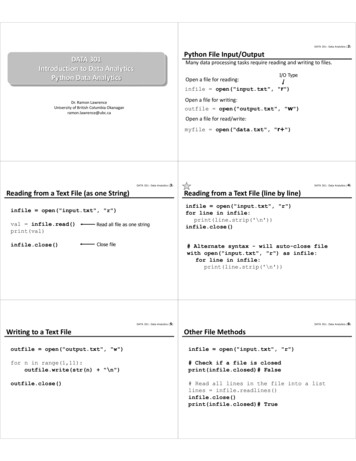
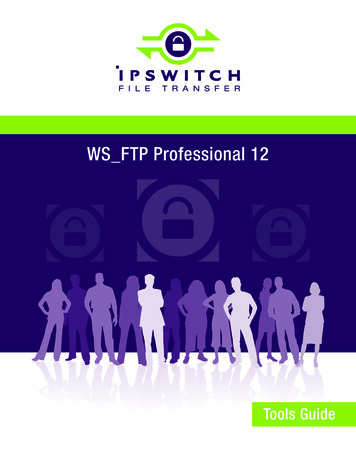
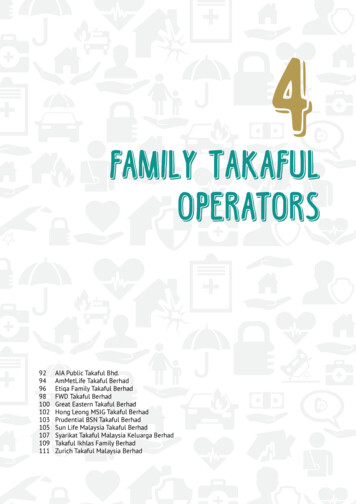
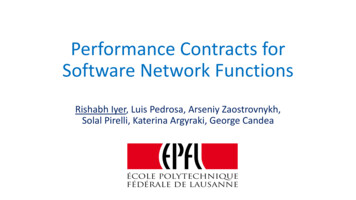

![Drawing the Human Head Burne Hogarth[English] - Internet Archive](/img/29/drawing-the-human-head-burne-hogarth-english.jpg)


